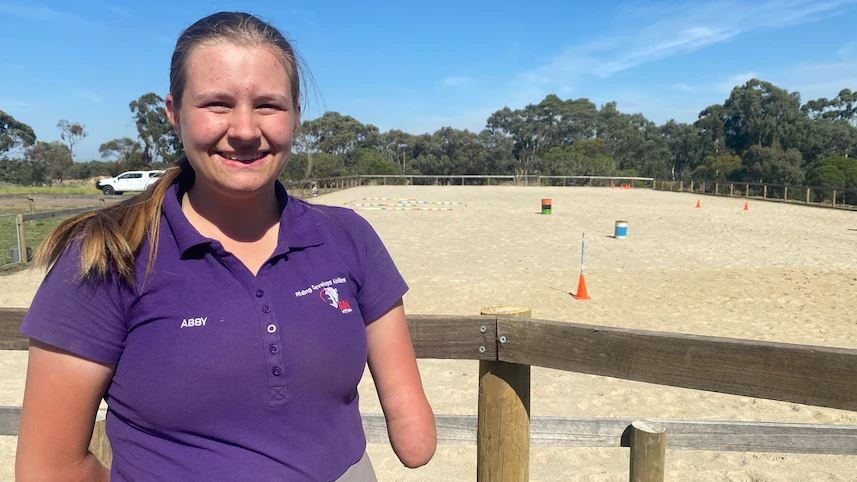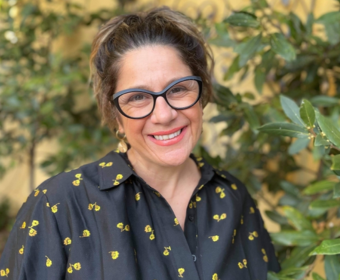Born with no forearms, 17-year-old Abby Vidler sets her sights on the Paralympics.
16 April 2021

Abby Vidler was born without forearms but it was not until she started primary school that she realised she had a disability.
“The teacher said, ‘Let’s all do finger painting’, and I couldn’t actually do that because I don’t have any hands,” she said.
“That’s when I was like ‘Oh, hang on a minute, I’m a bit different’.”
But the 17-year-old has not let that physical difference stop her from doing something others thought was impossible: riding horses.
She fell in love with the animals when she was just two years old when she started with Riding for the Disabled.
“Over years my passion has grown, I absolutely adore them,” she said.
“There is something special because they just do not judge you for who you are, they just love you and you can just forget about everything in the world because it’s just you and the horse in the moment.”
The year 12 student, who juggles riding multiple times a week with her final year studies, now competes with able-bodied riders and has her sights set on the 2024 Paralympic games in Paris.
“That’s where I hope to get and with pathways leading from Riding for the Disabled … this dream has now become a goal, so it’s pretty special.”
Abby’s riding coach Lyndsay Davis said it took about 15 years and a lot of trial and error to perfect her adaptive equipment, which was made by a man in Queensland.
“She has cuff and clips that fasten above her elbow which also has pins and attached to that is a piece of string that goes down to the saddle,” she said.
“So, in the event that Abby falls off the horse, the pin is pulled, and the cuff comes apart and she’s released from the horse.”
Ms Davis said Abby’s dream of the Paralympics was achievable, but she has a lot of work to do.
“Abby … hasn’t got those fine motor skills which make it harder, so she needs to be quite strong through her core also because she doesn’t have quite as much balance,” she said.
“But you wouldn’t think it if you saw her ride because she’s super, she’s really well balanced now and she’s riding really well.”
New arena in Melbourne suburbs hoped to reduce wait times
Riding for the Disabled has been operating in Victoria for 50 years.
It currently has a waiting list of more than 400 people and some have been waiting to join the association for over four years.
It is hoped a new arena in Wantirna South, in Melbourne’s outer east will drastically reduce that waiting list and allow more people with disabilities to thrive.
“This facility has been seven years in the making, it’s been a long journey which has only been made possible through a lot of fundraising, volunteer hours and government grants,” RDA Knox president Kathryn Holden said.
The site will see children from three years old to adults in their 50s and 60s.
“Some have autism, cerebral palsy, down syndrome and we also welcome people with intellectual disabilities,” Ms Holden said.
“We have many riders that are in wheelchairs who can’t walk, and what some of the riders actually say is, ‘Riding a horse gives me legs’.”
The Wantirna South facility also received a $200,000 government grant through the Pick My Project program, where the community voted for project ideas in their local communities.
“This project couldn’t be any more deserving, it’s very heartening that the community got behind this new centre,” Suburban Development Minister Shaun Leane said.
Abby said it was the self-confidence that she developed from participating in Riding for the Disabled that has been life-changing.
“Having that community and being surrounded by such a great bunch of people has made me such a confident young person,” she said.
“I just see myself as normal, I forget that I have a disability.”
For Lily, the stares were more than just curious glances
“I remember just feeling terrified and wanting to go home,” Lily begins.
“I wanted to shout, to scream that what they saw wasn’t who I was.”
For a brief moment, she considered asking her parents if she could switch to homeschooling, just so she wouldn’t have to interact with all the people who had othered her the moment they saw her.
As the day went on, Lily says she felt like some of her fellow students didn’t understand why she was even at the school.
“They didn’t seem to understand why someone like me was at a ‘normal’ school,” she remembers.
“Because I’m in a wheelchair, they thought I should be in a school for students with special needs.”
While Lily says most of her fellow students eventually relaxed around her, many continued staring at her throughout her six years at the school, and her high school education was punctuated by other people’s false assumptions about her, her disability, and her wheelchair.
Still, the teenager slowly made friends. With them at her side, she felt comfortable enough to begin the process of learning not to pay too much attention to those who regularly singled her out.
But the entire experience still had a significant impact on her mental health: Lily began to internalise the ableism she was experiencing.
“I was very upset and angry for a long time and felt very ashamed of myself,” she says.
“I used to hate the idea of being in my wheelchair in the community and being seen by other people [because of the way] people would always stare at me.”
This is why Lily wants you to know her story
Lily doesn’t want you to hear her story and feel inspired by the way she rose above it all, or for her experiences to be reduced to a feel-good tale about overcoming adversity.
She’s telling it because she wants to help change people’s perceptions about wheelchairs — though Lily is aware of the fact that everyone’s experience is different.
She wants you to listen because she believes if more able-bodied people saw her wheelchair as she does — as an extension of herself — they wouldn’t register it as something to stare at.
“Behind those stares and negative attention [are often able-bodied people] who don’t have any real knowledge of people with disability,” she says. “They’re just going off stereotypes.
“I think many able-bodied people don’t view wheelchairs as significant to the lives of those who use them,” she continues.
“I don’t believe able-bodied people understand how much their wheelchair is basically their lifeline.
“There would be no way for people in wheelchairs to get around and interact within their community [without wheelchairs]; they allow us to participate.”
Negative attention doesn’t come from nowhere
People With Disability Australia (PWDA) looks to models of disability to explain how mobility aids like wheelchairs can be perceived as “flaws” that require attention, instead of an extension of the person using them.
“According to the medical model of disability, ‘disability’ is a health condition dealt with by medical professionals. People with disability are thought to be different to ‘what is normal’, or abnormal. ‘Disability’ is seen to be a problem of the individual,” the national Australian disability rights and advocacy organisation says.
“From the medical model, a person with disability is in need of being fixed or cured.
“From this point of view, disability is a tragedy and people with disability are to be pitied.”
Giancarlo de Vera, who is a senior policy officer with PWDA, says “people seek to correct so-called conditions that ‘need correcting’ [because of the medical model]”.
“And that leads to people wanting to either internally correct themselves or impose their worldview on people who ordinarily wouldn’t want those interventions, had it not been for those attitudes.”
Mx de Vera says this can manifest in the everyday through people without disability seeing those with disability “as a ‘burden’ and as ‘objects that need to be helped'”.
“And at times it also means that they will try and stop people with disability from participating in things they have the right to, until those so-called ‘conditions that need correcting’ are fixed.
“This is how people with disability get excluded from everyday things that everyone else likes to enjoy, like socialising, connecting with friends and forming relationships.
“And that really, really becomes a dangerous situation.”
The alternative is the social model of disability, which is recognised by the United Nations Convention on the Rights of Persons with Disabilities.
The social model sees disability as constructed by “the interaction between people living with impairments and an environment filled with physical, attitudinal, communication and social barriers”, PWDA says.
“A social model perspective does not deny the reality of impairment nor its impact … it calls for accommodation of impairment as an expected incident of human diversity.”
But the effects of the medical model of disability are still being felt across every level of society.
Discrimination is an everyday reality for many people in Australia with disability and has been found to have myriad negative effects on health (including higher levels of psychological distress) as well as social and economic circumstances, according to the Centre of Research Excellence in Disability and Health.
Here’s how Lily feels about her wheelchair now
While she wishes she hadn’t had to, Lily’s grown used to the way people with limited knowledge of people with disability can view her wheelchair.
She admits it was a lengthy process: “It wasn’t an overnight realisation — it took me a long time to understand.”
Lily says acceptance came with the realisation that her wheelchair would always need to be a part of her life, and that things wouldn’t get better if she didn’t accept that.
“While my wheelchair is definitely part of my identity, it doesn’t define me,” she says.
“But I know that wheelchairs can mean a lot more to certain types of people.
“[People who use wheelchairs] are all different and we all have different opinions about things.”
Lily’s experiences have inspired what she wants her life’s work to be: at the moment, she’s studying social work at university.
“I understand how hard it is for younger people to see past their differences,” she says.
“And I want to make sure those people don’t feel alone — which is how I felt for a long time.”





